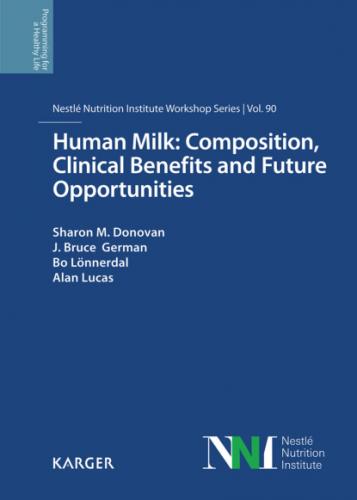Human Milk: Composition, Clinical Benefits and Future Opportunities. Группа авторов
W: Formula milk versus donor breast milk for feeding preterm or low birth weight infants. Cochrane Database Syst Rev 2014; 4: CD002971.
19Lucas A, Fewtrell M, Morley R, et al: Randomized outcome trial of human milk fortification and developmental outcome in preterm infants Am J Clin Nutr 1996; 64: 142–151.
20Lucas A, Lucas PJ, Chavin S, et al: A human milk formula. Early Hum Dev 1980; 4: 15–21.
21Sullivan S, Schanler RJ, Kim JH, et al: An exclusively human milk-based diet is associated with a lower rate of necrotizing enterocolitis than a diet of human milk and bovine milk-based products. J Pediatr 2010; 156: 562–567.e1.
22Cristofalo EA, Schanler RJ, Blanco CL, et al: Randomized trial of exclusive human milk versus preterm formula diets in extremely premature infants. J Pediatr 2013; 163: 1592–1595.
23Hair A, Peluso AM, Hawthorne KM, et al: Beyond necrotizing enterocolitis prevention: improving outcomes with an exclusive human milk-based diet.” Breastfeed Med 2016; 11: 70–74.
24Narayanan I, Prakash K, Murthy NS, Gujral VV: Randomised controlled trial of effect of raw and holder pasteurised human milk and of formula supplements on incidence of neonatal infection. Lancet 1984;ii: 1111–1113.
25Abrams SA, Schanler RJ, Lee ML, Rechtman DJ: Greater mortality and morbidity in extremely preterm infants fed a diet containing cow milk protein products. Breastfeed Med 2014; 9: 281–285.
26Lucas A, Cole TJ: Breast milk and neonatal necrotising enterocolitis. Lancet 1990; 336: 1519–1523.
27Roze E, Ta BD, van der Ree MH, Tanis JC, et al: Functional impairments at school age of children with necrotizing enterocolitis or spontaneous intestinal perforation. Pediatr Res 2011; 70: 619–625.
28Zhou J, Shukla VV, John D, Chen C: Human milk feeding as a protective factor for retinopathy of prematurity: a meta-analysis. Pediatrics 2015; 136: e1576–e1586.
29Assad M, Elliott MJ, Abraham JH: Decreased cost and improved feeding tolerance in VLBW infants fed an exclusive human milk diet. J Perinatol 2016; 36: 216–220.
30Kramer MS, Aboud F, Mironova E, et al: Breastfeeding and child cognitive development: new evidence from a large randomized trial. Arch Gen Psychiatry 2008; 65: 578–584.
31Singhal A, Cole TJ, Fewtrell M, Lucas A: Breastmilk feeding and lipoprotein profile in adolescents born preterm: follow-up of a prospective randomised study. Lancet 2004; 363: 1571–1578.
32Singhal A, Fewtrell M, Cole TJ, Lucas A: Low nutrient intake and early growth for later insulin resistance in adolescents born preterm. Lancet 2003; 361: 1089–1097.
33Singhal A, Cole TJ, Lucas A: Early nutrition in preterm infants and later blood pressure: two cohorts after randomised trials. Lancet 2001; 357: 413–419.
34Lucas A, Brooke OG, Morley R, et al: Early diet of preterm infants and development of allergic or atopic disease: randomised prospective study BMJ 1990; 300: 837–840.
State of Breastfeeding in the World
Donovan SM, German JB, Lönnerdal B, Lucas A (eds): Human Milk: Composition, Clinical Benefits and Future Opportunities. Nestlé Nutr Inst Workshop Ser, vol 90, pp 13–32, (DOI: 10.1159/000490322)
Nestlé Nutrition Institute, Switzerland/S. Karger AG., Basel, © 2019
______________________
Michael W. Woolridge
Great Ormond Street Institute of Child Health, University College London, London, UK
______________________
Abstract
Currently accepted “best practice” for managing breastfeeding effectively (WHO/UNICEF) is largely based on a historical view of how babies remove milk from the breast, which had persisted for several centuries. The collective wisdom was verified by imaging studies in the 1950s and 1980s, to reach a consensus view – clinical management principles, based on such research, have proved highly effective. Over the past decade, the mechanics of suckling, and how the baby removes milk from the breast, have been revisited, using modern imaging technology and by the application of engineering-based techniques, which seek to develop explanatory models of how suckling works. While the imaging studies have caused us to expand our view of the process, the engineering-based models have proved somewhat contradictory, tending to undermine the new consensus. Such models are complex, mathematically difficult to evaluate, and without simple lessons by which clinicians/practitioners can update their practice. This presentation will seek to demonstrate the current agreement between imaging studies, and elucidate recent engineering-based models of milk extraction, to achieve a fresh consensus – a “revised suckling physiology.” Certain limitations of the engineering-based models will be addressed, showing why they do not yet provide a definitive explanation of how babies remove milk from the breast. The encouraging news, however, is that current “best practice” for breastfeeding does not need to be updated; in fact, a new conclusion indicates that the guiding principles are even more relevant than before.
© 2019 Nestlé Nutrition Institute, Switzerland/S. Karger AG, Basel
Introduction
For the best part of four centuries, the medical world was secure in its view of how babies fed and removed milk from the breast – the terms “sucking” and “suckling” became mutually replaceable, even though they describe separate processes. Two commonly accepted facts remain today: first, the baby generates high levels of suction pressure in the oral cavity, so that any object placed in a baby’s mouth (bottle-teat, finger, pacifier) cannot easily be removed. Second, the baby’s tongue moves in a wave-like manner, with positive pressure being exerted rhythmically by the dorsum of the tongue surface to the underside of the nipple/breast complex held in the baby’s mouth; this is regarded as a type feature of the baby, taken to indicate its neurodevelopmental maturity.
The latter tongue movements, originally identified by practical observation [1–3], were later visualized using various techniques including cineradiography [4], 2D ultrasound [5, 6], direct filming [
